
| The earliest known glass salver, or server as it was sometimes called, was modeled after silver. In 1661 Thomas Blount defined the form as a 'new fashioned piece of wrought plate; broad and flat, with a foot underneath, and is used in giving Beer, or other liquid thing, to save or preserve the Carpit and Cloathes from drops.' Savers or salvers, made of glass are mentioned in English records as early as 1620, & like their silver counterparts, they functioned as serving trays. In period paintings they are often shown supporting one or more wine glasses. |
| In
English examples from the late seventeenth & early eighteenth
centuries the most popular style was the molded pedestal stem. This
stem lingered well
into the nineteenth century; after 1800 the edge of the foot is usually
folded upwards & most had solid tops. Glass salvers became closely associated with the serving of desserts, as depicted in a Joseph Highmore painting of 1741-45 where a single glass salver supports a set of jelly or syllabub glasses arranged around an orange glass.The most spectacular role of the salver was in a dessert pyramid comprised of two to |
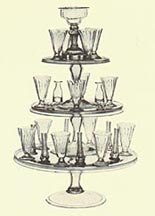 |
| five salvers of graduated diameter set one upon the other to create a pyramid effect. (See drawing above Right) Each layer bore an arrangement of glassware (syllabubs) filled with jellies, creams, & sweetmeats. The smallest salver at the top was usually crowned with a 'Top Glass' for preserved fruit. |
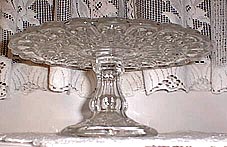 An early flint cake stand in the Thumbprint pattern ca 1850's |
Salvers were first made in America in the 1770s in Philadelphia. South Boston Flint Glass Works listed the form among its products in 1818; their salvers ranged from 8-15 inches in diameter and cost from $1.67 to $6.00 each. The following year, the firm extended the range down to 6 and up to 17 inches. Today's collectors find these regal pedestals extraordinary, but they were nothing but ordinary at the height of American pressed glass production in the later 1800s. |
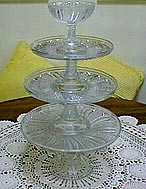 |
A stack of
Feather aka Doric pattern cake stands ca 1890s empty (L) and adorned
with Thanksgiving Goodies (R). |
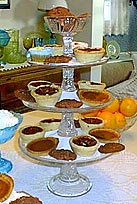 |
| Formed in brass or iron molds, pressed or 'pattern' glass was inexpensive to produce. Cake stands were turned out in a myriad of patterns to suit anyone's taste and in sizes ranging from 12" in diameter to petite children's 6" versions. The 8" diameter size made in some patterns are now referred to as 'doughnut stands'. | ||
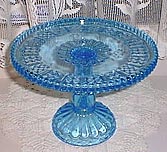 A sapphire blue 10" cake stand in a pattern known as COTTAGE; FINE CUT BAND; or DINNER BELL by Adams & Co. ca 1870s. |
In addition to being
made in crystal clear glass, some
stands were
offered in colors such as sapphire
blue, emerald green, amethyst, vaseline (canary),
amber, and apple green and with a variety of decor such as engravings,
etchings and frosted or color flashed portions. Colored cake stands are
difficult to find today. These popular serving pieces were sold as cake plates on a standard or as salvers identified by pattern numbers or plain names. Collectors have since given patterns more eloquent descriptive names. |
| Today a cake stand
that cost under
a dollar in the 1800s is worth anywhere
from $40 to $350 or even more depending on the rarity of the pattern,
age, condition and color. Luckily for collectors, pressed
glass cake stands are not widely reproduced although a number of
new patterns are being made en masse by Martha Stewart and others to meet the demand of the current cake stand 'rage'. So a couple of hundred years after they first appeared on American tables, footed serving plates show no signs of stepping out of the spotlight. |
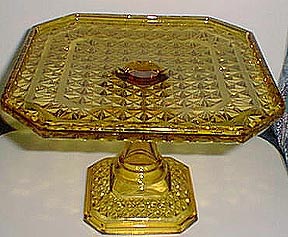 An amber cake stand in the
popular square shape in a pattern dominated by 'Finecut' design
probably from the 1880s |
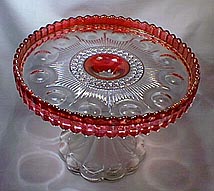 Very difficult to find ruby stained Manhattan aka New York pattern cake stand by U S Glass Co ca 1902. |
While
dining in America has evolved into a much more casual affair,
the practice of placing desserts on salvers, now better known
as cake stands- has passed from generation
to generation. From the ironstone and pressed glass stands churned out by Victorian factories to the "Elegant Glass" serving pieces marketed by companies like Fostoria and Heisey during the Depression era, cake stands remain appreciated as much for their graceful form as for their utility. |
 |
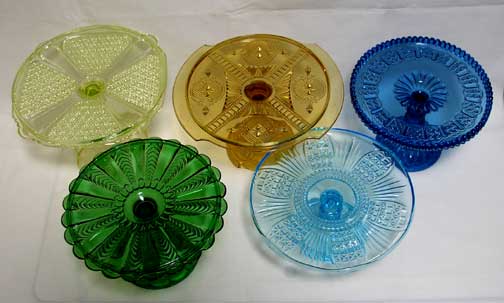 Shown in the grouping above are vaseline Finecut & Panel, amber Medallion, cobalt blue Cottage, emerald green Florida and sapphire blue Cathedral patterns. |
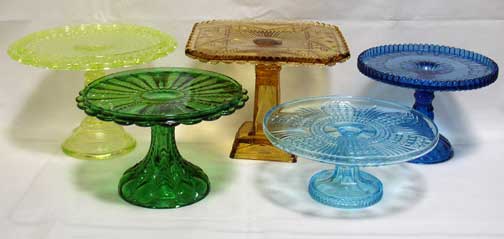 |
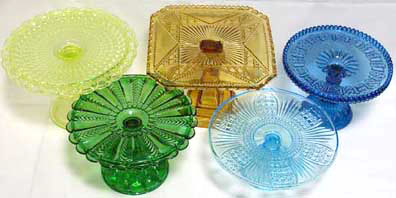 And shown in this grouping are vaseline Thousand Eye, amber Sunken Buttons, cobalt blue Cottage, emerald green Florida and sapphire blue Cathedral patterns. |
PatternGlass.com and many of them are shown in the
Pattern Glass Store. EMAIL us if you are looking for more.
 |
Believe
it or not, here is a 1958 advertisement for Pillsbury cake mixes
and isn't it sitting
atop a rare Four Face pattern glass cake stand (or shallow
compote?) made by St. Louis glass in France during the Victorian era! |


